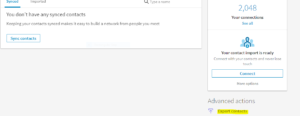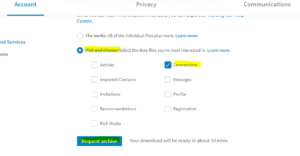 When you start a job search, reaching out to people you know for introductions and leads is critical. But it can be challenging to get a handle on and mobilize your network, particularly if it is large or if you have been out of touch with key contacts for a while.
When you start a job search, reaching out to people you know for introductions and leads is critical. But it can be challenging to get a handle on and mobilize your network, particularly if it is large or if you have been out of touch with key contacts for a while.
A great place to begin assessing the quality and quantity of your network is LinkedIn. Linked in allows you to export your contacts into a spreadsheet, which makes it much easier to understand who is in your network from a high-level view.
Once you have exported your contacts, create categories to differentiate the quality of each relationship on LinkedIn. Use some kind of sorting or color coding system to make it easy to examine the quantity of contacts in each category. Here’s an example of a sorting system.
Strong contacts; those you know well and could probably set up a meeting with fairly easily. Even though these people know you well, they may not be able to articulate your professional value proposition to others, so it makes sense to meet with them and share your positioning with them so they can make the right types of introductions. Highlight their names in yellow.
People you know well, but haven’t talked to in over a year. You need to figure out a strategy for reengaging with this group before launching into requests for information or introductions. Try reviewing their activity on LinkedIn first. Perhaps you can comment on something they wrote or liked. This type of activity often provides the ice-breaker you need to expand the dialogue. Highlight their names in blue.
People who are acquaintances, and who you would like to know better. This might be someone that you met at a professional event or had one business meeting with. You may have agreed to connect on LinkedIn, but then never did anything to nurture the relationship. For these contacts, try sharing or commenting on content they post to get on their radar and make it easier to initiate a conversation. Highlight them in green.
People who you are connected to on LinkedIn, but have no idea who they are. It’s not unusual to have several contacts who fall into this category. Take some time to evaluate each person and decide if it’s worth it to initiate a relationship. Follow their feeds to gain a better understanding of who they are professionally and who they are connected to. Highlight them in purple.
Consider doing a similar exercise for other databases you may have for storing contacts. This may be as sophisticated as a formal CRM system or as simple as an old address book or Roledex. The important thing is to capture all your contacts in one place so you can implement a strategic plan for your outreach.
Next, you will need to create a plan for how many people you will reach out to at a time. This will vary depending on your job status (someone in a full-time job and also in a job search will generally have less time to dedicate to their search activities). You need to create a situation where no one in your network has to wait to get on your calendar. You must be exceptionally accessible and flexible based on their availability. You may want to start reaching out to just a few contacts each week to determine the cadence of your efforts and then you can decide if and when to increase your weekly outreach.
Below are some screenshots to show you how to export your LinkedIn contacts.




